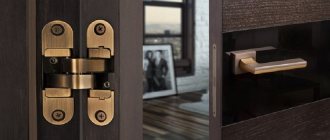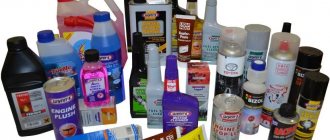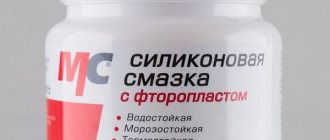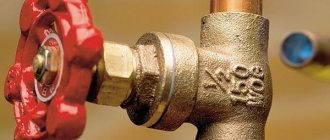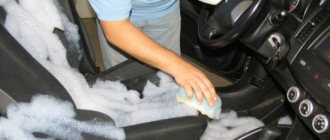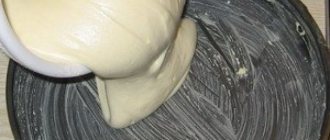Sooner or later, doors begin to creak in any car. Due to poor quality of assembly and fit, some models of the domestic auto industry or those produced in Southeast Asia begin to creak immediately after leaving the assembly line. Creaking in the doors of higher-class cars appears many years after the start of operation. The creaking that doors begin to emit comes in different tones, but the reason for it is the same - insufficient lubrication in the door hinges.
With new cars this happens due to an oversight during assembly. In cars that have been in use for several years, the oil film is squeezed out, erased, or simply washed away during pressure washing. Eliminating squeaking is very simple - you need to apply lubricant to the door hinges. And do this regularly so that the squeak does not return again.
The best option for treating car hinges and locks is silicone grease, which is produced by many well-known companies, including XADO, Forsters, TurtleWax and others.
Why do hinges begin to creak?
Creaking door sounds occur for several reasons, and they often appear in cars with a short service life:
- multiple opening/closing;
- unfavorable weather conditions;
- wear of the rubber bands responsible for the tight fit of the door to the body;
- poor-quality factory lubricant;
- door sagging;
- poor quality assembly of components, which is especially noticeable in domestic cars;
- very frequent washing of the car, because water, coupled with chemicals, washes out the lubricant;
- washing the car too rarely, as a result of which the lubricant becomes clogged with dirt.
However, even with systematic care of a good quality car, there is a possibility of door squeaks.
Dashboard
This is the most problematic area of most used cars. To understand where exactly the “play” is, you need to try pressing the plastic panels one by one while driving and listen to see if the sound has disappeared (therefore, it is better if there is an assistant in the car). You can also try to insert an unnecessary plastic card into the cracks that cause the most suspicion. If the grinding noise has disappeared, then the “cricket” has been found. All that's left is to get rid of him.
Healthy! To determine exactly at which joint the unpleasant sound occurs, it is enough to inspect the surfaces. As a rule, abrasions appear in such places.
There are two options for how to do this - simpler and more complicated:
- We completely dismantle the dashboard and put Modelin (one sheet of sound insulation will cost 760 rubles), Bitoplast (a sheet will cost 250 rubles) or so-called mushrooms (plates with small “outgrowths” that make the joints even tighter) into the joints. Particular attention should be paid to the panel's hinged elements (glove box lid, fuse box, clock, etc.).
We recommend: Why and how often to refill your air conditioner. How risky is it to do such a procedure yourself?
Healthy! Some people glue the joints with special tape or regular adhesive tape from the pharmacy.
- Pour silicone grease into the cracks (a can of WD-40 with a spout will cost about 250 rubles) and wipe off the excess with a napkin.
Silicone grease is the fastest and cheaper option. But you shouldn’t expect it to work for a long time, so the procedure will have to be repeated periodically. Fortunately, this composition is not conductive, so you don’t have to worry about “shorting” the dashboard.
Healthy! If the dashboard of a car consists of many parts (such as in the Chevrolet Lacetti), which are attached with self-tapping screws, then one disassembly is enough for extraneous sounds to begin to appear in the car. If this element is a monolith (as in Renault Logan), then even a used car will not have problems with “crickets” in this area.
Lubricants for car door hinges
Stores offer a wide selection of lubricants with different characteristics - it all depends on the preferences of the car owner. A lubricant for car door hinges is in demand among car enthusiasts; it prevents the formation of a corrosive coating for a long time - when applied, it creates a water-repellent layer on the hinge. Other compositions have high penetrating qualities, while others relieve working units from loads - dynamic and static.
Which lubricant to choose for car door hinges
Car doors should be lubricated with consistency compounds that have good penetration into the gaps and create a moisture-reflecting coating on the surface of the components. The material must:
- have excellent anti-corrosion qualities;
- minimize friction of elements;
- be resistant to temperature fluctuations;
- have a long service life;
- reduce friction of mating surfaces.
Choose a composition with little fluidity - too liquid ones will instantly lose their functions. If the store does not have a full-fledged lubricant, you can temporarily replace it with a grease material. Such compositions have good permeability and quickly neutralize annoying squeaking. Motor oil or lithol is also used. However, the oil evaporates quickly, and lithol is incredibly sticky, so it instantly attracts particles of debris.
Common lubricants
Lubricants for coating hinges in cars are divided into 2 groups - polymer and mineral.
Polymer
Polymer compositions are made on a silicone base. The lubricant is able to withstand severe temperature changes and other loads without loss of properties. Polymer lubricant is produced in tubes and in spray form. When working with paste from a tube, it is necessary to protect the skin of your hands with gloves. Spray lubricant is more convenient to use, as it allows you to reach hard-to-reach places.
Attention! Another type of polymer lubricant is technical petroleum jelly, but it is rarely used due to the poor quality of the product.
Mineral
Unlike polymer analogs, mineral coatings are more durable due to their consistency. In winter, they perfectly protect the door mechanism from moisture. One of the popular types of mineral lubricant includes lithium - it creates a strong barrier to moisture and reduces friction of door parts. Perhaps the only drawback of the product is poor protection of the hinges from corrosion. Places where the lubricant is applied in a thin layer succumb to rust faster.
What happens if you don't lubricate squeaking doors?
Creaking doors indicate a problem. The problem is the lack of an oil film between the rubbing surfaces of the door hinges. If there is no oil gasket, then metal rubs against metal and begins to “eat” itself. Usually one hinge wears out faster and one day the door will warp and you won't be able to close it. In addition, the friction point will become covered with rust and begin to rapidly deteriorate. In particularly advanced cases, the door may simply fall off.
Effective lubricants
After reading the top five, you will learn how to lubricate a car door to prevent squeaking:
- Liqui Moly Wartungs Spray Weiss.
- Wurth HHS 2000.
- CRC-MULTILUBE.
- Permatex 80075.
- Klever Ballistol-Silicon Spray.
Liqui Moly Wartungs
Liqui Moly is a common whitish-colored product containing microceramics. It has anti-corrosion and moisture-repellent characteristics, prevents the penetration of dirt particles into the door mechanism for a long time and reduces friction of structural parts.
Liqui Moly Wartungs Spray Weiss is a specialized product designed for processing movable parts, keyholes, hinges, rods, etc. The product is based on mineral oil. Temperature range of application - from -30° C to +250° C.
Advice! The Liqui Moly Wartungs composition can be used to coat not only hinges, but also all kinds of moving parts of a car.
Wurth HHS 2000
Wurth HHS 2000 lubricant is a product of German manufacturers that has won the special love of car enthusiasts. Car owners liked the lubricant due to its rapid thickening, excellent adhesive and penetrating properties, and good stickiness. Ideal for application to door hinges, locks, stops. The product is resistant to strong water pressure and prolongs the service life of mechanisms, even those operating under high pressure.
The main highlight of Wurth HHS 2000 is its rapid transformation from an aerosol to a thick lubricant. Thanks to this property, it reaches hard-to-reach places and remains there for a long time, protecting elements from moisture and reducing friction. The operating temperature range is from -30° C to +180° C. The main disadvantage is the adhesion of grains of sand, dust, and other debris. Plus - low cost.
CRC-MULTILUBE
A universal lubricating composition with high penetrating and water-repellent characteristics. Gets into the most difficult areas of mechanisms, creating a durable protective film. Thus, it significantly reduces the friction of the joints and prolongs their service life. Retains original lubricating properties even with sudden temperature changes.
Multilube has a distinctive feature - a bright blue color, which indicates areas not yet covered with the composition. Thanks to this, the car owner immediately sees where the lubricant is applied. A few days after processing the mechanisms, the product becomes discolored.
Permatex 80075
Permatex 80075 is a colorless lubricant that perfectly protects moving parts of door hinges from wear. Extends the service life of mechanisms and has high anti-corrosion properties. It is in a liquid state in the container, but at the moment of spraying it turns into foam. This allows the compound to reach hard-to-reach places, protecting hinge elements and keyholes from wear and squeaking.
Klever Ballistol-Silicon Spray
One of the materials used not only for processing metal parts, but also spare parts made of plastic, rubber and rubber. Provides a sliding effect of rubbing elements, significantly extending the service life of door “joints”. The spray contains silicone, which allows it to be used at any time of the year - both in cold and heat.
Attention! The universal fluid WD-40, known to most car enthusiasts, or simply “Vedeshka”, has excellent anti-corrosion properties, but quickly washes out the lubricant.
Where does the squeak come from?
First of all, the cause of this problem is unfavorable weather conditions (strong wind, snow, rain) plus frequent use of doors and wear of the rubber bands that are responsible for tightly connecting the doors to the car body.
So, the door in your car began to creak. What to do? Should I run to the auto store or use improvised means - different oils that are stored in an assortment at home on a utility shelf or in the garage and used in everyday life?
Previously, car enthusiasts did not particularly think about this issue; the hinges were lubricated with literally everything that came to hand. Vinegar, kerosene and even iodine were used. We do not recommend that you use such extreme means now; it is better to choose a more reliable and repeatedly proven means that can penetrate the gaps between the rubbing parts of the door hinge and create a film that prevents further friction.
What is the best way to lubricate car door hinges?
To lubricate door hinges, it is better to choose compounds that meet the following criteria:
- prevention and destruction of rust;
- maintaining properties at very low or too high temperatures;
- maximum friction reduction;
- penetration into hard-to-reach places;
- long service period;
- low price with good quality.
It is important to buy products that have fluidity - otherwise, the interior and body of the car will be difficult to wash off stains. Many drivers like products based on molybdenum disulfide. This product is excellent for bearings, transmissions and engines, but you should not lubricate door “joints” with it - the product is easily soiled and attracts a lot of dirt.
General requirements
Without focusing on a specific manufacturer or type of lubricant, when choosing a suitable composition for locks and hinges, a number of requirements should be presented to the product. They are common to all, and consist in ensuring that the lubricant has:
- viscous structure;
- high strength;
- resistance to work at low and high temperatures;
- good lubricating properties;
- stability of physical and chemical properties;
- resistance to mechanical stress;
- wear resistance;
- water-repellent characteristics;
- anti-corrosion resistance.
If the lubricant you choose meets all these criteria, you won’t have to worry about locks and hinges. They will be under reliable protection. But it will have to be periodically monitored and the layer of lubricant renewed as it wears out and becomes thinner. Here are a few examples of what products can be used when processing door hinges and locks.
How to properly lubricate hinges
It is a misconception that to eliminate squeaking it is enough to spray the hinges on top with an aerosol or treat only the working parts. The effect will be, but short-lived, and soon the creaking sound will return.
- You must first remove any accumulated dirt from the hinges using a wide brush. It will not be possible to do this simply, since sand and dust particles are mixed with a lubricant - you will have to treat it with regular gasoline or white spirit.
- Remove gasoline residues with dirt, as well as traces of corrosion using a rust converter.
- Apply new compound to the hinges. The effect will be greater if the mechanism is not completely filled with the product, but only the surfaces of the mating areas are smeared. Wipe off excess product with a rag.
- Open and close the door 15-20 times to evenly distribute the lubricating components throughout the hinge. Also remove excess with a rag.
If after lubrication the doors continue to creak, there are a number of reasons for this:
- the lubricant was of poor quality/outdated;
- the doors sagged;
- old grease was poorly removed, leaving debris particles.
Important advice! It is best to process the loops after washing, in the autumn, when there is no longer any heat, but the cold has not yet set in.
Lubrication procedure
It is impossible to fully carry out the procedure for lubricating the door hinge without disassembling the mechanism. So, to process the parts you need:
- Arm yourself with an open-end wrench and unscrew the bolt securing the locks.
- Slide the door handle in the direction opposite to the door opening and remove it.
- If the handle does not come off, you should slightly rock it in different directions.
- Find a couple of levers inside the door and carefully apply lubricant to them.
- Also treat the inside of movable locking elements and handles. The locking mechanism can be reached by removing the protective plastic cover.
- Remove excess lubricant with a rag.
- Reinstall the lock and handle.
- Open and close the door several times, listening to see if the squeak remains.
In order not to constantly disassemble the locking mechanism, you can use an aerosol with a special tube. Insert one end of the tube into the lock, the other into the sprayer.
Another unpleasant moment characteristic of the winter-spring season is the freezing of the door along the contour of the seal. This often happens after washing the car or during a thaw, when the daytime temperature rises and drops sharply in the evening. In this case, there is a risk of tearing off the seals or not opening the car door at all. Silicone lubricant designed for rubber products can be a salvation.
An unpleasant squeak when opening/closing a car door can be prevented if you regularly, at least 1-2 times a year, apply a lubricant to the stops and hinges. This can be done using a 25 cc medical syringe.
Don’t be lazy - before winter, be sure to remove the locks and lubricate the door mechanisms from the inside. This way you will protect them from rapid wear and tear and save yourself from the unpleasant creaking sound.
Do not leave the car wash in cold weather without drying your car first. Spend 5-10 minutes drying, and to speed up the effect, open and close the doors several times in turn. Excess moisture will drain out on its own, and you will have peace of mind for your car.
Frequently asked questions and answers
Why can't you heat the castle with boiling water? I don't see any harm. Answer: hot water can damage the coating of your car due to a sharp temperature change, and also, after the boiling water cools down, it will freeze again, but this time more strongly, since you deliberately poured it there yourself. It will also cause corrosion of the locking mechanism during warming, and then you will definitely have to change the locks.
What about the exhaust method? Answer: Exhaust gases are equivalent to breathing, the effect may be there, but the larva will also quickly “seize” again after it.
I tried to clear the lock with a pocketknife, since I didn’t have anything else at hand. The mechanism broke and had to be replaced. How to carry out prevention in winter so that this definitely doesn’t happen again? Answer: Initially, your idea of such “cleaning” was a failure, since you drove the ice even deeper. Drive the car into a warm box for at least a few hours so that it thaws, clear all the snow from all doors and seals, then wipe it dry. Treat keyholes and seals with moisture-displacing silicone or graphite grease. If your car is on the street, purchase a car cover and cover your car with it. Clean the doors periodically with a brush and you will be happy.
I used the defrost - it didn't help. Are there any analogues to this remedy? Answer: You may have received a low-quality or expired cylinder. If you did everything according to the instructions, then there should be no problems. Let us remind you: inject the product directly into the lock cylinder, wait a while, if it does not help, repeat the procedure. Usually the lock opens the first or second time.
Is it possible to use anti-freeze if there is nothing else at hand? Answer: It is possible, but it is not advisable. Since it is alcohol-based, but do not forget that it contains water.
